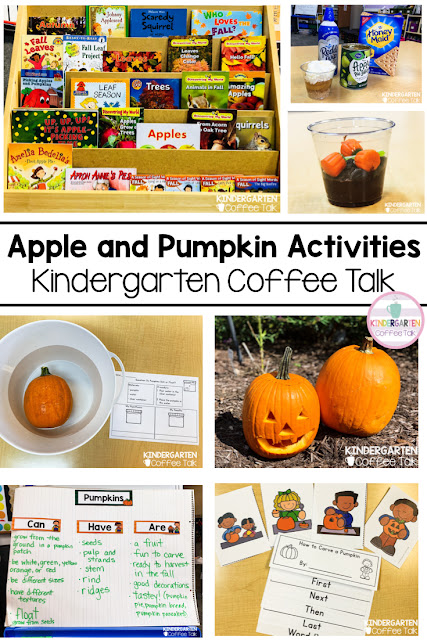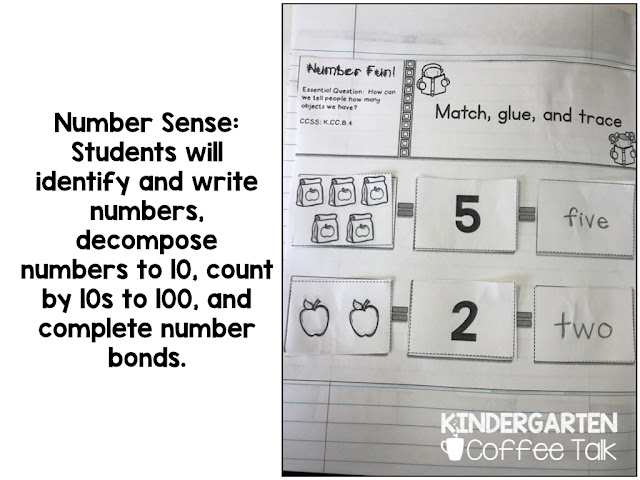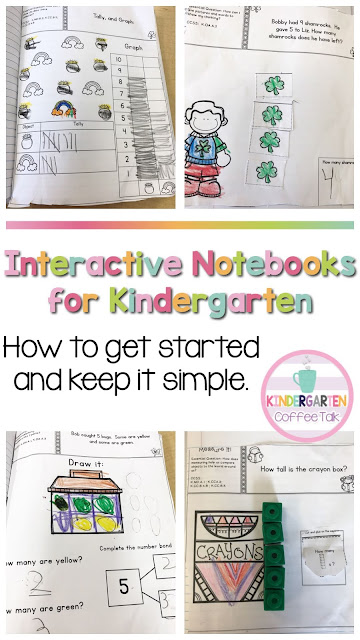I love using math interactive notebooks in kindergarten. They are a routine that we establish early on that carries our learning throughout the school year. The first couple of weeks are slow moving, but once we get it a groove it is smooth sailing after that.
Getting Started:
To be honest, I have found two different ways to get started with interactive notebooks that have been quite effective for me. I choose between the two depending on the class that I have.
Option 1: I like to start my students doing a version of "workstations" early on in the school year. During this time, we play get familiar with our math manipulatives and I teach students about staying in one spot, voice level, and how to clean up neatly and completely before moving on to the next workstation. I also take this time to teach students about stamina and we start of at the workstations for about 5 minutes and start adding one minute a day as soon as they are ready. Once we get up to 10 minutes per station and the group is working at one spot with a level 2 voice level, I pull kids to my small group table and I guide them through cutting, gluing, and completing our pages.
Option 2: We begin math notebooks together and I guide them through cutting, gluing, and completing the pages while using a document camera.
But isn't it a lot of steps?
Yes, in the beginning, we take it slow. And when I say slow, I mean S-L-O-W! In my classroom, I use both community supplies and individual supplies in a pencil box. For interactive notebooks, we use pencil boxes (just a personal preference of mine- community supplies are great too). We practice getting out our pencil boxes, where we need to put them, and how we need to sit to get ready for math notebooks. In the beginning especially, I usually keep and pass out the notebooks. Later on in the school year, the kiddos can be responsible for that too. We also practice getting out our glue sponges and tidy tubs as well. If you have never heard of glue sponges, you MUST check out this post from
Kindergarten Smorgasboard. Life changing...seriously! Tidy tubs are our trash collectors that are on our tables so that we don't have to get up to recycle any of the paper until we are done. Yay!
Once we can do all of those things, we are ready to get started with the page. This is critical: I show the kids one step, stop, and then let them do it. We continue that until we have completed all of the cutting. This is often my stopping point for day one. Then on day two, we glue and do the page together the same way we did the cutting...step by step (anyone else singing New Kids in their head right now?).
A few more tips and tricks:
1. Have your highlighter and scissors ready. In the beginning of kindergarten, fine motor skills are at so many different levels. A highlighted line or a simple cut goes a long way.
2. Glue sponges are the best for interactive notebooks! They keep the paper attached to the notebook. Glue stick glue just doesn't keep it attached for the whole year.
3. If you have multiple interactive notebooks, pick a color of duck tape for each type of notebook and put it on the spine. It is so much easier to organize that way!
4. Hot glue a piece of ribbon inside the back cover of the notebook to use as a bookmark. Then, minimal time is wasted flipping to the next empty page in the book.
What do they look like?
1. My math notebooks are spiraled practice. Once we get in the groove, on Mondays we measure, Tuesdays we tally, Wednesdays are word problems, Thursdays are geometry, and Fridays we practice number sense. I love this because once the kids learn how to do each type of page, they can look at the page, know what to do, and get started right away. Each page has minimal steps... thats just how I roll. If it is too complicated or feels too much like an art project, I won't do it. Lol!
2. These struggling students and English Language Learners have done really well with these notebooks. They are concrete enough that they can complete even the word problems, but challenging enough to keep everyone learning and reviewing information.
3. As the kids get in the routine, interactive notebooks take about 10 minutes. I fit them in at the end of my small group time before they go to workstations.
A week of math interactive notebooks:
Here is what a week of math notebooks look like in my classroom at the beginning of the school year. The activities grow and change throughout the school year for spiraled practice.
Monday:
Tuesday:
Wednesday:
Thursday:
Friday:
Want to try some interactive notebooks? Click
here to download a whole week for free!
Any questions? Please feel free to email me. We LOVE interactive notebooks in our classroom and I hope you will too!
Happy Teaching!

















































